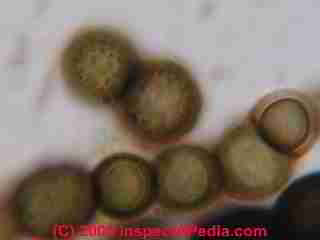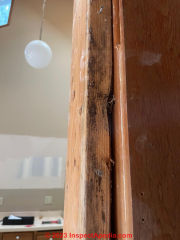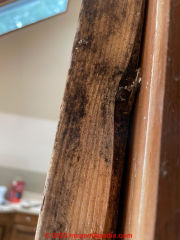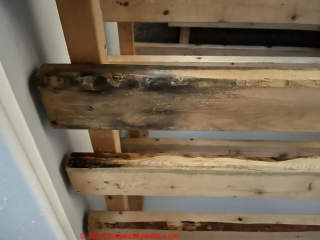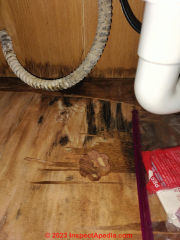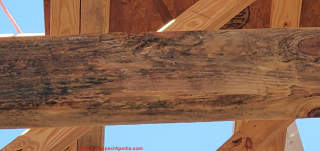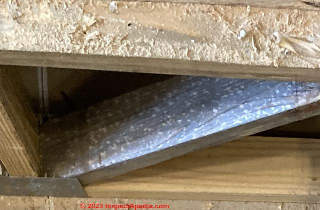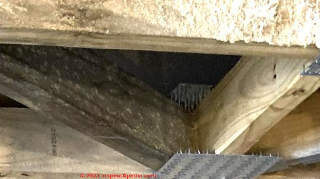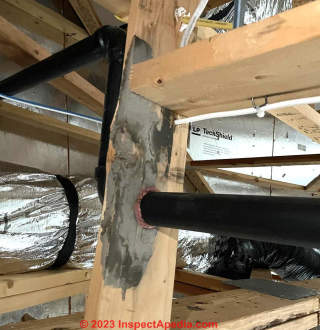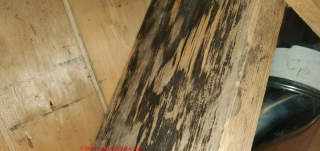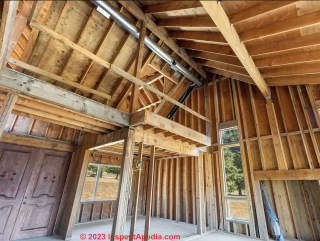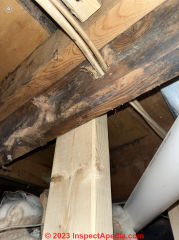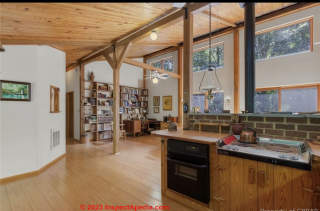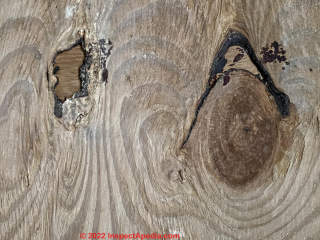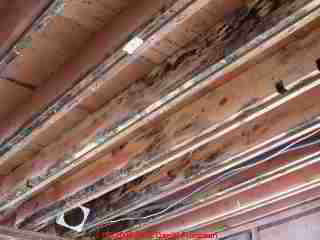 Identify Harmless Black Mold on Indoor Surfaces
Identify Harmless Black Mold on Indoor Surfaces
- POST a QUESTION or COMMENT about cosmetic black or dark colored mold in buildings
How to recognize harmless black or dark colored indoor mold.
Photographs of harmless cosmetic black mold on indoor surfaces. How to recognize cosmetic or harmless Ceratocystis or Ophistoma "bluestain" mold indoors.
When investigating a building for a mold problem, you can save mold test costs by learning how to recognize Harmless Black Mold but which is often mistaken by some untrained or inexperienced "mold inspectors" or "mold remediators" as more serious contamination which they call "toxic black mold".
Here we provide photos of other indoor materials that are not mold. Identifying sap stain fungal growth on wood, lumber, logs, etc. Are there remedies for removing fungal sap stain fungi problems on wood? Sure but it's not functionally necessary.
InspectAPedia tolerates no conflicts of interest. We have no relationship with advertisers, products, or services discussed at this website.
- Daniel Friedman, Publisher/Editor/Author - See WHO ARE WE?
Harmless Cosmetic Black Mold in Buildings
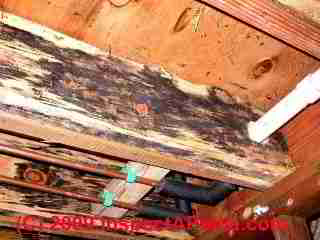 Some black mold in buildings arrived on the framing lumber and is harmless both to humans and to the building materials on which it is found.
Some black mold in buildings arrived on the framing lumber and is harmless both to humans and to the building materials on which it is found.
Often a visual inspection for certain clues (discussed below) can make you very confident of when mold appeared on lumber and what sort it probably is.
[Click to enlarge any image]
Because some clients have on occasion sent samples to our lab that really should not have been collected, much less looked-at, we provide this library of photographs harmless indoor mold and of things that are "not mold" and don't need to be tested.
In many cases these are substances that you can easily learn to recognize in buildings by simple visual inspection of the mold and its abutting and surrounding surfaces.
Save your mold test money, and increase the accuracy of your mold contamination inspection or test for toxic or allergenic mold in buildings:
review these items to learn recognize non-fungal materials or even possibly harmless cosmetic "black mold" often mistaken for "toxic fungal growth."
Definition & Images of Sapstain Wood Fungi
"Sapstain" fungi are molds that grow principally on or in sapwood.
There are three groups of sap-stain molds commonly discussed in the literature. Some literature also refers to "bluestain" fungi that is just about the same grouping. What are sapwood and heartwood anyway?
Sapwood forms the main portion of a tree while heartwood is found only at the center of the tree. Most building framing lumber is almost entirely sapwood.
(this just means molds whose spores appear dark or "black") including the two most common mold genera on earth,
Cladosporium sp.
(the "king of molds"), and Alternaria sp. (A runner-up for mold king based on frequency of occurrence).
Black yeasts,
a sub-group of the mold family that include two very common molds Aureobasidium sp. (often found in moist attics on plywood as well as on wood framing), and Rhinocladiella (less often found in buildings).
Our photo above shows a closeup of Aureobasidium sp. under the microscope. More mold microphotos can be seen
at MOLD by MICROSCOPE,
and photographs of common molds found in buildings can be seen
at MOLD APPEARANCE - WHAT MOLD LOOKS LIKE.
Ophistomoid fungi, a group that includes Ceratocystis sp. and Ophistoma sp., and related fungi - these are the most common cosmetic black molds found on framing lumber and sometimes on plywood, and are the main subject of this article - see our page top photo as well as more photographs below.
Because it is difficult in the lab to distinguish between Ceratocystis sp. and Ophistoma sp. by microscopic examination, and because these are not problem molds, most labs combine and report these fungi in lab samples as either Ophistomoid fungi, or as Ceratocystis/Ophistoma group fungi.
Watch out: building materials with cosmetic mold on them can also support growth of other problem mold species if later conditions are right for new mold growth.
Many of our lumberyard samples of mold on wood examined in our own study of this phenomenon, especially samples collected from (wet) pressure-treated lumber contained both harmless cosmetic molds and an overgrowth of potentially harmful molds including mostly Penicillium sp. and some Aspergillus sp.
So inspect "cosmetic" mold growth areas carefully using good lighting techniques -
see FLASHLIGHT HELPS FIND MOLD for details. Make sure that the obvious harmless "black mold" you see (such as shown in the photograph at left) is the only mold growth found.
As we describe later in this article, while most cosmetic mold can simply be left alone, we suggest that you do not assume that just because wood is obviously stained with cosmetic mold, that no harmful molds are present, particularly where damp, wet, or treated lumber is involved.
Other fungi may also be present, so a closer look might be appropriate.
But if the mold growth is interrupted, it almost certainly was on the lumber at time of construction and is unlikely to represent an active building mold problem.
That does not mean there could not be some other indoor mold problem, but if your mold looks like the photo on the rafter in the left of the photo just below, you are not looking at active building mold growth.
Interrupted Mold Growth Confirms No Active Mold Growth on Indoor Framing Lumber
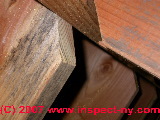 Cosmetic molds [photo]
such as the Ceratocystis sp./Ophistoma sp. group of Ascomycetes are not likely to be harmful to people nor to the wood they're found on.
Cosmetic molds [photo]
such as the Ceratocystis sp./Ophistoma sp. group of Ascomycetes are not likely to be harmful to people nor to the wood they're found on.
In these photographs of black mold on building framing you can see that the black mold "stops suddenly" at the photo at left or here at the cut end of a rafter [photo] and where a rafter meets the roof sheathing [photo].
Incidentally, that light brown material on the rafter in the upper right of our photo (left) is mud from construction, not mold.
"Interrupted" mold growth in this pattern forms unambiguous and compelling evidence that this mold was on the particular rafter at the time of construction.
You can see the interrupted black mold growth on framing lumber in our photo at left as well as the two black mold on wood framing photographs above on this page.
While there are technical exceptions (such as mold growth interruption on drywall at a drywall taping joint), in general, indoor surface growing mold does not stop at an arbitrary "straight line" cut in or on a building material.
You can see this interrupted mold pattern growth on drywall
at SAMPLING DRYWALL.
Other dark growths that may look "black" on wood surfaces
include black yeasts such as Aureobasidium, often A. pullulans, as well as some of the most common species of Cladosporium sp.and Alternaria sp., some of the more common dark molds that we find on plywood roof decking in attics and on occasion on rafters.
You can see photographs of these other dark post-construction attic molds
at ATTIC MOLD, WHAT IT LOOKS LIKE.
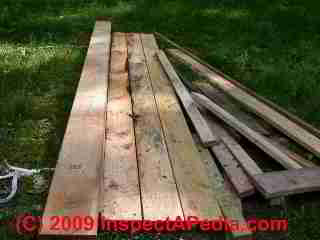
But the dominant "black mold" found on framing lumber at the lumber yard and in new construction,
as well as remaining in homes after construction have been completed are the ophistomoids Ceratocystis and Ophistoma, whereas Aureobasidium sp. and Cladosporium sp. are more likely to have developed on a building surface after construction.
"Pressure Treated lumber"
which is sold as resistant to rot and resistant to wood destroying insects is very often not only wet when purchased, but is often mold contaminated with several species of Penicillium sp. or Aspergillus sp.
We confirmed this condition by a survey of building materials at several lumber suppliers in New York, using tape samples of visible mold on the surfaces of these products as well as by testing framing lumber found at active building sites (photo at left and others on this page).
Various sources have reported that Ophiostoma grows in culture on media that contains cycloheximides, an agricultural fungicide that inhibits protein synthesis, so it is plausible to pose that it may have grown on wet treated lumber after the wood was processed with fungicides intended to prevent insect attack.
It's ironic that treatment to prevent termite or carpenter attack on framing lumber appears to actually increase the growth of these molds on the same product.
We also found that sometimes "green" pressure-treated lumber, often Southern yellow pine (SYP), contained both cosmetic black molds (described above) and additional Penicillium sp. or Aspergillus sp.
We don't know if the latter molds appeared later in the life of the lumber, perhaps parasitically on top of existing biological materials, but there was no doubt that it was present on new pressure treated wood which we examined both at building supply houses and at some building sites.
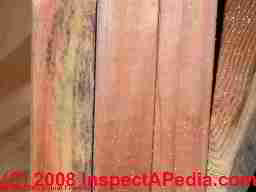 An example of a parasitic mold commonly found growing on the ophistomoids is Gonadobotryium sp. [photo]
An example of a parasitic mold commonly found growing on the ophistomoids is Gonadobotryium sp. [photo]
Here's another example [photo] showing that a single pre-moldy-2x joist was used to make a built-up basement beam - photo of black mold on a built-up wooden girder or beam?
Mold is visible on only one of three 2x12s? This is not live mold growing in the attic nor basement. A microscopic examination confirmed that these surfaces (above left) were Ceratocystis/Ophistoma.
More about stuff that looks like scary black toxic mold but is actually something else, something harmless, is
Reader Question: is this cosmetic mold or not?
Is this black mold harmless cosmetic or something else?
 Reply:
Reply:
The mold in your photo, such as the dark mold on wood framing in what looks like a ceiling space, is almost certainly not the mold problem in this home as it's almost certainly a cosmetic mold such as those discussed above on this page - one can see that by the mold growth pattern at intersections of the framing lumber.
Watch out: That does NOT mean that there's no mold problem in the house.
The other photos showing evidence of water leaks argues that hidden mold risk could be significant.
For example your other photos
of WATER BLISTERS in PAINT (illustrated by your photos found in our separate article on paint failure types) indicate that there are other building leaks that need to be addressed.
What to do about Cosmetic Molds on Indoor Building Surfaces
If you are reasonably sure that you’ve got mold like Ceratocystis/Ophistoma that came in on the lumber at time of framing, it’s harmless and also is not likely to grow into a bigger problem
. In fact indoors we have never found Ceratocystis/Ophistoma mold in an active growth state inside of a building – we imagine that it needs different (wetter) growing conditions than found in a building. Indoors, even if Ceratocystis/Ophistoma mold was alive, it’s cosmetic-only.
Cleaning or removal of a cosmetic mold is entirely optional and would be done (or not) in a building for reasons of appearance, not health.
Leave Cosmetic Mold Alone on Dry Indoor Framing Lumber
If the cosmetic mold you see is like that in our photographs on this page, that is, there is no evidence of active mold growth and the mold obviously came from the lumber yard and the lumber is dry, or kiln-dried, and the environment where the wood is found has remained dry, the mold is only cosmetic and no action is necessary.
Clean Moldy Pressure Treated Framing Lumber that is to be Used Indoors
When using pressure-treated lumber for interior framing,
clean off any visible mold. Simple power-washing would suffice
This step is not necessary and would be inappropriate for the same lumber when used outdoors, such as for a deck or an entry stair. But inside, such lumber may be used for sill plates or in some cases we have seen it used to re-frame a rotted floor over a wet crawl space.
Importing a large Aspergillus sp. colony on the floor framing surface over a crawl space provided an immediately-detectable high level of airborne Aspergillus sp. in the room above this area, as these spores move easily in convection air currents moving from the crawl area up through the building.
For this reason, if visibly moldy treated lumber is to be used in indoor construction we recommend that it be physically cleaned first - such as by using a power washer and deck cleaning solution. "Sterilizing" such lumber to try to "kill" mold is unnecessary and inappropriate.
Just clean the moldy lumber, don't try to sterilize it.
See MOLD KILLING GUIDE for details of why killing mold is not the most useful approach.
What if I remove "cosmetic" indoor mold and it reappears? If you remove a mold you believe was "cosmetic" and later you find new mold growth in that area:
- the original mold was not a cosmetic genera/species and is one that can grow indoors or
- you have an entirely new fungal growth problem
- you need to remove the new mold growth and you need to identify the reason it formed (a leak or moisture problem) and you need to correct the cause
ANY indoor building condition that produces or has produced new or recurrent indoor mold growth on building surfaces means
there is also a risk of both visible and hidden problematic molds of genera/species other than just cosmetic molds.
Even when you test and identify a specific mold on a building surface you should not assume that the mold you've identified is the only problem, or even the most serious mold problem in the building, unless you have also completed a through, expert diagnostic inspection of the building.
To prevent problem indoor mold
your focus should be on watching for and correcting leaks or moisture problems in your building. For details on how to prevent indoor mold growth in buildings see:
- BUILDING FLOODS: quick steps after a building flood or plumbing leak can prevent costly mold contamination
- MOLD ACTION GUIDE AFTER FLOODING: How to Minimize Mold Damage After a Building Flood
- HOW TO PREVENT MOLD: how to avoid mold growth in buildings: priorities, repairs, products
- HUMIDITY CONTROL TO AVOID MOLD: How Low Should You Keep Indoor Humidity to Avoid a Mold Problem
- MOLD-RESISTANT BUILDING PRACTICES some detailed suggestions from an expert on preventing mold growth indoors
- OZONE WARNINGS - Use of Ozone as a "mold" remedy is ineffective and may be dangerous.
- MERULIPORIA INCRASSATA - "Poria" the house eating fungus Meruliporia incrassata or perhaps a different mold, Serpula lacrymans - which one is the "house eating fungus" - what it house rotting mold like in a building and under the microscope
In summary about cosmetic indoor mold:
If at present you’ve found evidence of mold growth inside of a building other than Ceratocystis/Ophistoma then it’s moisture and leaks that need your attention, not the Ceratocystis/Ophistoma.
Impact of Cosmetic or Harmless Black Mold on Home Sales
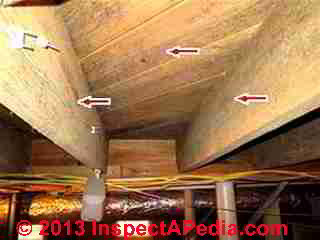 Reader Question: what to do when seeing cosmetic mold trips up the sale of a home
Reader Question: what to do when seeing cosmetic mold trips up the sale of a home
Recently I was in the process of selling my home, a 1958 brick ranch with basement daylighted on all but one side
. In selling the house the buyer’s inspector made note of mold on the floor joists over the basement which of course immediately scared of the buyer because the inspector didn’t bother to explain molds, types etc.., I am not sure he did any testing only a visual.
I am certain from looking that it is the harmless cosmetic mold you mention in some of your articles that often begins when wood is brought to the job site etc.
It shows what you call in some of your articles interrupted mold growth and has been on the joists for the full 10 years I have lived in the house without any growth etc..,
I am sure it has always been on the wood and the dust accentuates it. In fact, my inspector when I purchased the home said it was normal.
The basement is completely dry even in what has proven to be a very wet season this year.
However, now I am in a dilemma since the one inspector has made mention of mold. Should I test and treat it? If I have it tested and its harmless type can I treat it myself or now that it has been noted should I have a professional to do so? Any suggestions on how I get around this becoming an issue for future potential buyers?
In my opinion this is one of those cases where I wish the general public was more educated and the inspectors would be more thoughtful not to generalize. I fear this will keep my home from selling.
Any thoughts and advice would be greatly appreciated. Also if you have recommendations of reputable companies in Atlanta that won’t take advantage I would greatly appreciate that as well. - Anon. 9/4/2013
Reply: do we need to inspect & remediate a mold problem or not? Should every house be "mold tested??
You want your buyer to be fully and accurately informed - a step that protects both buyer and seller from surprises, but indeed some less-experienced or nervous inspectors, or folks who just don't know about a topic may protect themselves from a complaining client at the expense of accuracy - no one is well served by shortcuts: the community's time and money may be wasted.
Watch Out: Mold "testing" is often not really justified and more often is not conducted in a way that gives accurate, reliable results anyway; but if a large area of visible mold is noticed, it should be called out to avoid a scary or costly surprise later.
The "interrupted growth" pattern is pretty obvious and along with the appearance of the moldy surface and other details often is enough to avoid any panic; but not everyone agrees. I had a client who was furious with me when my inspection (and lab tests) confirmed that a "black mold" in his home (on wood framing) was cosmetic and did not require a multi-thousand dollar demolition that he wanted to make.
"Truth," he said, "should not get in the way of my remodeling job. I need this finding to get insurance coverage."
Should Every Home be Tested for Mold?
Without seeing your site and having more data I can't give certain advice; for example on occasion I've found harmful mold growing happily atop cosmetic mold - in particular on damp pressure-treated lumber, and on occasion on wet framing in an existing building indoor area.
Without some basis (leak history, building IAQ complaints, inspection by an expert, perhaps a simple supporting lab test of representative moldy surface) I would NOT treat the mold; that step risks
- wasting money
- feeding an unjustified public fear of "black mold"
- marking the home as having had a "mold problem" that raises questions about cause, location, hidden mold reservoirs, the need for more testing
- puts a seller at risk if s/he represents a home as "mold free" without adequate expert evidence (no building is "mold free" anywhere except maybe inside of a computer "clean room" or a hospital operating room.)
I just can't support recommendations to perform expensive inspecting and testing for every "mold alarm" that is raised.
At MOLD / ENVIRONMENTAL EXPERT, HIRE ? we include some suggestions on deciding when such investigation is warranted.
In sum, if I were selling a home and encountered a buyer wary of a suspected mold problem, and if that were causing a stumbling block I'd perhaps be forced to ask for an independent and truly qualified expert who could take enough of a look (and possibly some surface or dust tests) at the building that we could decide if there were an actionable problem or not.
That person should be paid by the buyer so that there is no worry of conflict of interest; you can give-back that fee at the sale closing if you prefer. Check with your attorney.
IF there is no real basis for a proper and reliable mold inspection - i.e. the appearance is of only cosmetic mold, there are not water, moisture, IAQ, or health complaints nor such history, etc. - then a qualified or competent expert ought to be able to reach that conclusion by an onsite inspection of the building (outside and in) along with a taking of building & occupant history.
If Mold is Found is Expert Remediation Needed?
If an inspection finds indoor mold contamination, that is other than "cosmetic" mold, and if there is more than 30 sqft of contiguous problematic indoor mold, then it's proper to have it addressed professionally and to have a final clearance inspection;
If not, a DIY cleanup or cosmetic treatment is normally adequate, with the proviso that if during cleanup a larger problem is discovered work stops to bring in a professional.
Beware of capture errors: someone focusing on (perhaps harmless) mold that is seen in a building may fail to miss more urgent building health and safety concerns - more people are hurt by falling down the stairs.
Watch out: Beware also of consultants who take the "safe" course of spending more of other people's money to reduce risk to the consultant. If you want to send along photos of your situation as well as text from the inspector's report so that we know what s/he actually saw and reported, I may be able to comment further.
Reader follow-Up:
 attached is a picture of areas in question [above, and the basement walls without water staining - at left]. Mold is mentioned on the wood floor joists.
attached is a picture of areas in question [above, and the basement walls without water staining - at left]. Mold is mentioned on the wood floor joists.
It is a 3 sided daylight basement, very dry (included picture of cmu wall also, hopefully you can see dry cmu walls from that, the basement itself is not wet at all) and the picture you see also has much dust on it.
Once the dust is wiped off it is much cleaner but the darker coloration is linear in fashion in the wood (black and green), wood is solid etc.., very little if any musty smells.
Our intent was to wipe it down carefully with DIY using baby wipes or similar that can be wiped once and bagged.
Our biggest concern is now that it is on a report as mold (most likely only from visual inspection) we will have to hire a professional to ensure protection for potential future buyers.
Maybe I am wrong but I believe this inspector has made a much bigger deal out of something that probably should not be. My believe is at best he should have made a notation that there is potentially mold…, until which time we could have had it evaluated.
Any suggestions you have on how we should best proceed to correct any problems and secondly to protect from the mold scare of future buyers would be greatly appreciated.
Reply:
I'd be careful: on T&G pine subflooring I do find a variety of fungal growths; your photo is not super sharp - I can't assert this is cosmetic-only. Problem mold conditions can occur from even a single event in a building's life even if the building has not regularly flooded. Even during construction.
Take, or have a neutral third party take a couple of tape samples that you and the neutral party agree are representative of the substance found in wide areas on the subfloor and joist sides; If there are multiple-colors, then take more than just 2 samples (one subfloor, one joist) - one per color or texture difference.
You can mail to me up to 4 samples for lab analysis - I'll process them pro-bono as a courtesy and to avoid any issue of conflict of interest, and will report to you what I find in the samples.
To make sense of such a report you need good evidence that where you collected the samples does represent the areas in question. When I've done such tasks I photo-documented the sampling location, labeled tape on the surface, and I kept a control sheet identifying each sample.
Physical wiping and HEPA vacuuming; any household cleaner is fine. You're not trying to make the area sterile, just get rid of a potential problem particle. Using disposable wipes improves the cleaning process as you reduce the spread of debris from the first wipe stroke to the second. But it may be overkill. Clean the surfaces.
If after cleaning you want to use a clear sealant or fungicidal sealant that's ok though not necessarily required. Sealing wood immobilizes remaining particles and reduces moisture uptake, so reduces the propensity to support mold in the future.
Use the procedures found at DUST / MOLD TEST KIT INSTRUCTIONS - it's quite easy - and just include a copy of our email correspondence with your samples.
Please do NOT send samples in any other form than described in that web article unless we have discussed them first. We will examine your samples in our forensic lab and email you a report with our observations.
Keep in mind that in some buildings there may be no visible mold or the visible mold that you see may not be the most significant mold reservoir or problem there.
Similarly, people may have building-related complaints where there is no mold or other particle hazard present at all. Finally, small amounts of indoor mold, of just a few square feet, if that's all that is present, would be very unlikely to explain a building-related health complaint.
Small areas of indoor mold can usually be cleaned by just about anyone using ordinary household cleaners.
See DO-IT-YOURSELF MOLD CLEANUP WARNINGS for details.
How to Get Rid of Sapstain or Blue Fungal Growth in Wood
 Reader Question: I am a chainsaw carver who deals with blue fungi mold in logs - how can I get rid of blue fungal growth on my wood?
Reader Question: I am a chainsaw carver who deals with blue fungi mold in logs - how can I get rid of blue fungal growth on my wood?
I am a chainsaw carver who deals with blue fungi mold in logs; I have attached a photo. Can you provide information on this and getting rid of it; I have numerous colleagues who also like to know! - S.N.
Reply:
Nice photo, S.N. I can't ID a mold fungus from that or any photo alone (only a fool would claim to).
That said, it's indeed possible we're looking at a blue sapstain such as Ceratocystis sp. or Ophistoma sp.
But before we go messing with bleach - a cosmetic repair that has its own problems, let's run through some diagnostic questions about wood stains and blue sapstain fungal growth in your wood.
1. Let's make sure it's not some contaminant that fell onto the wood,
or that a fungal growth is not being encouraged by how wood is stored or by something else left lying atop the wood that traps or holds water. In the photo the stain looks as if it has run from water - was this log slice standing vertically or on an angle?
And there is something odd about most of those stains being all in a straight line like that.
Normally mold growing on wood would begin from a spore landing on the surface, and would grow often in a rounded pattern out from that point; spores or fungi don't land on wood in a dead straight line.
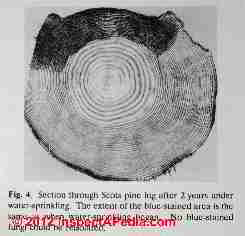 Sapstain fungal growth (bluestain) may indeed not look random on the wood, as our photo from Winfield shows at left. The fungal growth is probably following the cellular structure of the wood itself from where the first inoculating spore(s) found a home.
Sapstain fungal growth (bluestain) may indeed not look random on the wood, as our photo from Winfield shows at left. The fungal growth is probably following the cellular structure of the wood itself from where the first inoculating spore(s) found a home.
Our other photos (below) show additional typical mold growth patterns on wood & lumber.
But something straight that was placed on the wood might indeed cause straight-line staining.
That makes me wonder if your stains are in fact being caused by stickers you are using to separate slabs of wood you are trying to dry (stickers themselves are too wet or are a poor material choice), combined with a slow drying process, possibly aggravated by storing your wood exposed to rain and in warm weather.
Woodweb discusses sticker stain and provides some excellent advice if this is the root of your stains.[19]
2. Let's do a little testing for wood penetration of the stain.
Have you tried cutting a sample with a gouge chisel or knife?
Does the stain extend into the wood grain or is it mostly surface? I suspect you'll reply the stain has penetrated the wood surface (which these sapstain fungi certainly do.)
3. Does the stain always appear in this pattern on all of your wood samples?
Take a look at the example photos I include from our two reference texts.
4. Is this stain in the wood when you buy it or cut down the tree,
or is it appearing on the wood while you have it in storage, perhaps drying?
5. Check with local mold test labs
to see if the lab could examine both a wood gouge sample of stained (and a control of not-stained) wood (just a 1/2" square would do) and a tape sample if you can get the material onto a clear adhesive tape.
See MOLD TEST KITS for DIY MOLD TESTS -
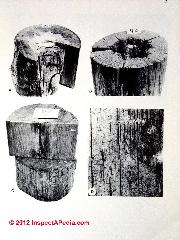
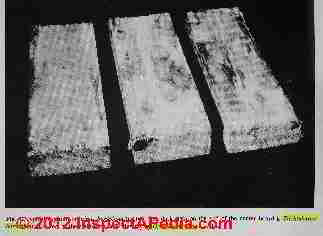
If you are already certain it's a fungus it's probably blue sapstain such as one of the two species I've cited above, and that I discuss online
at COSMETIC MOLD, RECOGNIZE, you'll see in my photos that the mold does not grow on wood surfaces quite like the pattern in your photo.
My reference texts on this topic, by Wingfield et als, has (p142) sapstain photos in black and white.
I'm posting here copies of some reference in-situ mold on wood photos for your comment (or comments from other readers) along with similar images from Wang & Zabel the other useful text for this topic. [1] [8]
Remedies for Sapstained Logs, Log Slices, Wood or Lumber?
Unfortunately if the bluestain is deep into the wood it's almost impossible to remove completely. Worse, we have read that some fungi may be present but not visible as a stain until the wood has been further dried & cured.[19]
I've had some success with detergent followed by careful treating with bleach solution, and a thorough washing off a wood surface to reduce or eliminate stains (and bleach odors) in a finished product.
But deep stuff is hard to deal with. Selection of wood not already visibly infected, and prevention of mold growth on stored wood by attending the conditions on which we store it may be in order. I know that may be tough for a chainsaw wood carver, since you work with big sections of logs that remain outdoors. Let's get more confident in our diagnosis and then pursue remedies further.
Blue stain or sapstain prevention (& sticker stain prevention) in or on wood
Handling moisture, both in the wood itself, and in the environment where wood is stored for drying and before use, is the single most effective thing you can do to reduce fungal growth on and in the wood itself.
Speeding the wood curing or drying process, including storing wood on separation stickers, off the ground, and under cover (protected from rain and snow but not in an airtight enclosure) could make a significant difference in the rate of bluestain or sapstain occurrence on your wood.
If your wood stickers are not absolutely dry (below 10% moisture) they could be causing sticker stain as we discussed above and as I suspected from the stain pattern in your photo.
If your wood is not stained when you first rough-cut it, you may be able to retard if not prevent sapstain growth by dipping the log sections in a fungicidal chemical (or enzyme). The problem is that the wood may be inoculated and your treatment may not penetrate the lumber adequately.
That's why pressure-treated wood is "pressure treated" (though the pressure treatment target is not fungi and the chemicals used don't seem to retard fungus growth in that case).
...
Reader Comments, Questions & Answers About The Article Above
Below you will find questions and answers previously posted on this page at its page bottom reader comment box.
Reader Q&A - also see RECOMMENDED ARTICLES & FAQs
On 2023-12-05 by Archie Leeming - does cosmetic mold smell?
Thank you for this informative page. I just tore down a wall in a house that seems to have some cosmetic mold on the struts.
Can Cosmetic mold create a musty smell in a house?
we do have a known active mold outbreak in the attic that we are about to get professionally removed, but i am wondering if we can ever get rid of the musty smell if there is cosmetic mold present on the struts?
On 2023-12-05 by InspectApedia Publisher - No
@Archie Leeming,
If the mold you see on framing lumber is that cosmetic mold described above on this page it would not be a source of moldy odors.
If you smell mold, then there is mold, not dried on framing lumber Ceratocystis or Ophistoma, that is the source. And you report having such a contamination that is to be addressed.
However a more subtle possibility is that leaks or trapped moisture can also cause other mold genera/species to grow on wood framing lumber that previously was marked by the cosmetic molds described above on this page.So if your wall studs and cavity were wet some further inspection and probably cleaning are in order.
On 2023-12-06 by Archie
@InspectApedia Publisher, Thanks for the reply and help. That's good to know that if it's cosmetic mold it's not adding to the musty smell
. Here is a picture of the strut. the white dust is drywall. It had a layer of black fuzziness that easily brushed away. you can see some of these spots where i have touched the wood.
On 2023-12-06 by InspectApedia-911 (mod) - abrupt change in mold growth showing that it does not extend onto touching surfaces
@Archie,
In general when you see dark black mold growing on a piece of wood and the growth stops exactly at the edge of the wood and does not extend onto the surface of other wood material that the first piece is touching, then we think that the mold came in on the lumber at the time of construction.That's an argument for identifying what you see as cosmetic mold of the types that we describe in this article.
I mentioned earlier that it's always possible that new fungal growth can occur on the same lumber and be mixed in or on top of the older mold.
A fine point of distinction is worth keeping in mind here.
If the adjoining wood is significantly different, such as in your photo where the adjoining wood appears to be finished perhaps with a stain and a polyurethane or varnish surface, that wood is much less receptive to picking up moisture and so is more mold resistant.That kind of juxtaposition can confuse this question. So you should look at other abutting surfaces that the wood stud is touching such as drywall or exterior sheathing or other framing.
On 2023-12-06 by Archie
@InspectApedia-911, There was no sign of the mold on the drywall. so hopefully this isn't a mold growing on top of cosmetic mold.
On 2023-12-06 by InspectApedia DF (mod)
@Archie,
I agree that that sounds reasonable.
On 2023-08-21 by Leslie - extensive black mold under roof on plywood and on trusses
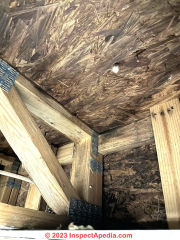 I have had mold issues with my apartment since last November. I noticed water dripping from the ceiling when I first moved in (last November) and maintenance “looked at it” but didn’t see a problem.
I have had mold issues with my apartment since last November. I noticed water dripping from the ceiling when I first moved in (last November) and maintenance “looked at it” but didn’t see a problem.
I only saw water dripping once so I took them at their word. Over the next couple of months, orange and black mildew began growing on the ceiling above my shower.
Put in another maintenance request and they came, sprayed some spray and told me to run my fan after I shower, and the high humidity was the cause of the mildew growth.
I kept my fan on 24/7 and it eventually broke. Mold began growing again so they painted with an anti mildew paint and installed a new humidity sensing fan that automatically runs at a certain humidity. It was on 24/7 after that.
A few more months go by and the ceiling begins showing hard water stains (or so I thought). Then, last week I came home and there was a brown puddle in my shower that had leaked from the ceiling.
Come to find out, the tub from the apartment above had a crack in the grout which had caused the leak, and the entire plywood underneath was completely soaked.
After cutting a huge hole on the ceiling, they put in a fan and a dehumidifier to “dry it out” and help with the abnormally high humidity.
I questioned them about mold but they kind of just brushed it off, and said they would do a test if I was concerned but they were “confident there was no mold” and because they dried up the moisture mold wouldn’t form.
I wasn’t convinced, and I have pictures of the inside of the ceiling that I took while it was opened up. They tried to tell me that because there was no airflow in the ceiling, mold could not grow and emphasized they tested and found zero moisture and the humidity in the bathroom had decreased.
I am not an expert, but from looking at the pictures it looks like mold to me. I’m hoping you can give me your opinion and let me know what you think.
When bringing it up, they told me it was grayish now and was just “discoloration of the wood” and if it was mold they would take care of it as it would harm their building which is what I would think too, but everything has just been so wishy washy so far.
I would also like to add that I am allergic to mold(I have had allergy testing done) and ever since I’ve lived in this apartment my allergies have gotten much worse and I am sick much more often.
Here is another image where you can see the line of where the water line stops.

On 2023-08-21 by InspectApedia Publisher - black material on roof sheathing looks like mold
@Leslie,
The black material on the underside of roof sheathing and on parts of the wood framing (looks like roof trusses) is most likely one or more mold genera/species.
The run-down stain below some of the framing nails tells us that this area has been quite wet.
Don't be fooled: "black mold" is not the only mold of concern, it's simply a mold color that's easy to see.
On 2023-08-21 by Leslie
@InspectApedia Publisher,
Would you recommend a DIY mold testing? Like a kit from Amazon or something? The complex was adamant there was no mold and they went ahead and covered the ceiling back up.
I asked for the results of their mold testing in writing but they said they don’t have anything specific from their test but could “write something up for me.”
On 2023-08-21 by InspectApedia Publisher
@Leslie,
If you want to sample the surface and send that to a mold test lab a useful procedure is at
TAPE & BULK SAMPLING & TESTS for MOLDBut in my OPINON there is no value in testing that moldy roof sheathing - there's extensive black mold growth - at least that's what your photos look-like to me. It's time to
- clean and seal the surfaces
- find and fix the moisture sources
On 2023-07-30 by Steve - black mold on wood shelving wrapped in plastic
I recently had a rebuild due to leak above a room and wooden shelves were remove and weeks later rebuilt with same wood that sat outside wrapped in plastic. I saw dark section and are they mold. I’m about to finalize with water damage and insurance people
On 2023-07-30 by InspectApedia Publisher
@Steve,
I'm not sure what is the construction that we're seeing in your photo - it doesn't look like shelving.
I see dark, probably moldy wood, nailed or screwed to cleaner wood onto which the same mold does not extend, so it's obviously old.
Clean the wood surfaces using any household cleaner, let it dry, and perhaps paint or seal it both for cosmetic improvement (as cleaning won't remove darker mold materials that stain the wood beneath its mere surface), and also to improve its resistance against moisture-up-take and thus to make it more resistant to future mold growth.
On 2023-05-23 by Lucy - mold under kitchen sink - mold killer, baking soda didn't work
Hi I'm so glad I crossed your site. I know by an image you can't tell if if the mold is toxic or not. This mold is under the kitchen sink on a water surface it was caused by a breakage of a pipe... Pretty much flooded. I sprayed disinfectant mold killer and added baking soda... But a year later this is how I found it now.
I would like to know what kind of mold do you think it is by just looking at the image.
On 2023-05-23 by InspectApedia DF (mod) - can't identify the specific mold genera/species from just a photo
@Lucy,
Nobody with any actual training in mycology, will pretend that we can identify the specific mold genera/species from just your photos. You've stated this yourself. And spraying "mold killers" like bleach are not effective so the source of any mold may still be present.
The helpful news is that for the steps to clean, remove and prevent mold contamination, the mold genera/species don't matter because the steps to take are the same:
- Remove the mold by cleaning surfaces
- Remove mold-suspect or wet insulation
- Remove any wet or moldy drywall
- Clean the exposed surfaces
- Fix the cause of the mold which in your case was a broken pipe
It may be that the leak continued for sometime before it was discovered which of course increases the probability of mold growth in that area.
It seems from your photo that the areas that appear to be dark and perhaps moldy and wet are quite small, certainly less than 30 ft.² of continuous mold which would be the threshold at which you would hire a professional.
Read more at
HOW TO PERFORM YOUR OWN MOLD INSPECTION & MOLD CLEANUP
There we give the basic steps for dealing with a mold problem.
Please take a look at that article and let us know if you have additional questions.Important added note:
Watch out:
While the total area of moldy materials in your photo suggests that it's small (less than 30 sqft) and within the capacity of ordinary homeowner or handyman cleaning, the real risk here is water damage and mold that are hidden from view under or behind the base cabinet.
Spraying disinfectants or sprinkling baking soda are not helpful and not effective.
If this were my cabinet I'd remove the bottom in the base, inspect below and decide based on what I find if the cabinet can be kept in place or needs to be removed. If it can stay, replace the base bottom.
On 2023-04-25 by Net - mold on new wood trusses
Thoughts? New trusses just installed.
On 2023-04-25 by InspectApedia Publisher
@Net,
Your photo is a good match for the mold examples we give above on this page.
Look for the clear indication that mold doesn't continue from one point of would contact to a different structural member.
On 2023-04-26 by Net
@InspectApedia Publisher, thanks. It definitely doesn't continue across boards. Although it's only been a few days. Was just concerning. Here's another view. Thanks!
On 2023-04-26 by InspectApedia Publisher - Trusses with black discoloration
@Net,
Good, you're probably OK, but be sure to read the article above including the section where you'll find
Watch out: building materials with cosmetic mold on them can also support growth of other problem mold species if later conditions are right for new mold growth.
On 2023-03-02 by Anonymous - gray spots on wood - are these mold?
Hello, I see a few gray-black discolored chord members in my open web truss system randomly scattered on this one particular truss. The discoloration is not contiguous. Is this consistent with the type of harmless mold present at time of construction? House is 1 year old. Thank you.
On 2023-03-03 by InspectApedia Editor
@Anonymous,
We can say with confidence that whatever it is on that dark spotty wood truss member, it was there when the truss was constructed.
But sorry, from your photo I can't see clearly enough even to know if that's mold.
If it's mold, it does not resemble either of the two types of cosmetic mold that we describe in the article above.
From what we can see, it's not something to panic about, but it would be worth pursuing a little further.
If you use a bit of clear Scotch tape to press onto the suspected moldy material, does that produce a sample of particles on the tape? If so, you could send that sample to an environmental test lab to see what you've got. If you decide to do that, keep me posted.
TAPE & BULK SAMPLING & TESTS for MOLD
On 2023-03-04 by Anonymous
@InspectApedia Editor , here is another picture of a different member (not adjoining)
On 2023-03-05 by InspectApedia Editor - try to clean wood spots and then seal with fungicidal sealant
@Anonymous,
For peace of mind, why not clean those surfaces as best you can, let them dry thoroughly, then seal with a fungicidal sealant. Less than 30 sqft of contiguous mold means hiring a costly mold remediator isn't necessary.
Read details at
MOLD CLEANUP, DO IT YOURSELF
MOLD CLEANUP GUIDE to GET RID OF MOLD
MOLD SPRAYS, SEALANTS, PAINTS
On 2023-02-26 by Stephanie - gray stuff on wood
Our new home is currently being built and this grey/black substance is popping up in multiple locations. Is this something to worry about?
On 2023-02-27 by InspectApedia Editor
@Stephanie,
That gray stuff on the wood 2x in your photo got there before the building was constructed - notice that. it doesn't continue over onto any of the abutting wood surfaces of other framing members. It might be concrete, or something else.
On 2023-01-28 by Rashid - black stains on wood porch swing
Hi, these stains are on our porch swing, can you comment on what it could be and how to get rid of it? Thanks
On 2023-01-28 by InspectApedia Publisher
@Rashid,
There may be some dark mold or algae in the area of those stains but the proximate causes are probably
- corrosion of the fasteners, perhaps nails that were not corrosion resistant
- collection of water in the splits in the wood caused by the fasteners.,
You can try sanding and even bleaching but I'm doubtful that those stains are superficial: more likely the extend more deeply into the wood.
On 2022-11-09 by Anastassia - is this cosmetic black mold?
Hi, is this a lumber mold? All other joices look OK, just this one is abnormal.
On 2022-11-09 by InspectApedia (Editor)
@Anastassia,
Yes. Please take a look at the article above
On 2022-09-25 by Sam - Does this look like lumber mold?
Hi, Does this look like lumber mold? There is a lot of staining on the left side, but the right side is more orange. What do you think? Thank you.
On 2022-09-26 by InspectApedia-911 (mod) - water stains are not mold
@Sam,
I see what look like water or leak stains on the underside of the roof decking
On 2022-09-20 by Kp - mold after small leak doesn't look typical
Is this mold ? Had a small leak and opened ceiling in the basement and see this, it doesn’t look like typical mold to me but wanted another opinion. Thank you.
On 2022-09-20 by InspectApedia-911 (mod)
@Kp,
That looks like old mold on old wood and a new 2x4 nailed up that has no mold on it - at least none that I can see.
That suggests that the mold on the old darker wood is not a current or recent event.
On 2022-09-16 by Nikki - buying a home - is there mold at the peak?
We are considering making an offer on this house and would like your opinion on the black area at the peak of this wall. It stops suddenly to the left. The slope is very steep and there no evidence of mold growth on any other surfaces.
You'll need to zoom in to see the black area. Thanks for any advice! - Nikki
On 2022-09-16 by InspectApedia-911 (mod) - ask home inspector about ceiling concern
@Nikki,
The photo locks sufficient clarity and definition to have a confident opinion about what that dark area is, but the general pattern and location does not at all look like a cosmetic black mold instance.
Frankly from the photo I can't tell that it's not simply a shadow.
Why don't you see if you can get some better images including some sharply focused close-ups. It's also important to understand the structure of the roof above, the presence or absence of ventilation, and any evidence of a history of leaks or trapped moisture.
And of course you wouldn't buy any home without a thorough Home Inspection so it's a good question to ask your home inspector.
On 2022-08-15 by Corinne - scared of knots in subfloor - I bleached them
This is in the subfloor under my house. I can smell it in the room above, which has lanolium. I sprayed the black spots that are on the knots with bleach but that didn’t work. Any idea what this is. I live in a humid environment but this mold is localized and the area has not gotten wet.
The suspected mold areas are the dark knots in the plywood. You can see how they have been eaten away. Maybe it’s not mold.
On 2022-08-15 by InspectApedia-911 (mod)
@Corinne,
That could be mold in those knots, though I'm not certain from just the photo.
The quantity is so small that even if that's mold it couldn't explain a building indoor air quality issue.
I thought I could see some much larger areas of light white deposits on framing - dust or white mold, hence my earlier suggestions.Honestly I can't see much in your photos, but, then, some molds are light in color and hard to see. Certainly I don't see the "cosmetic black mold" shown above on this page.
Take a look at:
MOLD APPEARANCE - WHAT MOLD LOOKS LIKE
and also
LIGHT, USE TO FIND MOLD
Spraying bleach won't fix a mold problem - as we explain atBLEACHING MOLD, ADVICE https://inspectapedia.com/mold/Bleach_Mold_Contamination.php
you'll want to clean the surfaces and find and fix the moisture source.
MOLD ACTION GUIDE - WHAT TO DO ABOUT MOLD
On 2022-08-16 by Corinne
@InspectApedia-911, maybe my husband has been right all along in saying it’s not mold. Thank you for looking.
On 2022-08-16 by InspectApedia-911 (mod)
@Corinne,
What I said is that IF that is mold, it's trivial in quantity AND I warned you to look at those white deposits that, if that's mold, would be significant.
...
Continue reading at COSMETIC MOLD, RECOGNIZE or select a topic from the closely-related articles below, or see the complete ARTICLE INDEX.
Or see BLACK MOLD, HARMLESS, FAQs - questions and answers posted originally on this page
Or see these
Recommended Articles
- ATTIC MOLD, HARMLESS COSMETIC? - distinction between harmful and harmless mold in attics or under roofs
- BLACK MOLD IDENTIFICATION - online mold photographic library of what black mold looks like in buildings
- BLACK MOLD, TOXIC & ALLERGENIC
- BLUE STAIN / SAPSTAIN / BLACK MOLD STAINS on wood
- COSMETIC MOLD CLEANUP EXPENSE
- MOLD APPEARANCE - WHAT MOLD LOOKS LIKE
- MOLD CONTAMINATION IN BUILDINGS - home
- MOLD / ENVIRONMENTAL EXPERT, HIRE ?
- PHOTOS OF MOLD ON WOOD SURFACES
- WOOD FRAMING & PLYWOOD MOLD CLEANUP
Suggested citation for this web page
BLACK MOLD, HARMLESS at InspectApedia.com - online encyclopedia of building & environmental inspection, testing, diagnosis, repair, & problem prevention advice.
Or see this
INDEX to RELATED ARTICLES: ARTICLE INDEX to MOLD CONTAMINATION & REMEDIATION
Or use the SEARCH BOX found below to Ask a Question or Search InspectApedia
Ask a Question or Search InspectApedia
Questions & answers or comments about cosmetic black or dark colored mold in buildings.
Try the search box just below, or if you prefer, post a question or comment in the Comments box below and we will respond promptly.
Search the InspectApedia website
Note: appearance of your Comment below may be delayed: if your comment contains an image, photograph, web link, or text that looks to the software as if it might be a web link, your posting will appear after it has been approved by a moderator. Apologies for the delay.
Only one image can be added per comment but you can post as many comments, and therefore images, as you like.
You will not receive a notification when a response to your question has been posted.
Please bookmark this page to make it easy for you to check back for our response.
IF above you see "Comment Form is loading comments..." then COMMENT BOX - countable.ca / bawkbox.com IS NOT WORKING.
In any case you are welcome to send an email directly to us at InspectApedia.com at editor@inspectApedia.com
We'll reply to you directly. Please help us help you by noting, in your email, the URL of the InspectApedia page where you wanted to comment.
Citations & References
In addition to any citations in the article above, a full list is available on request.
- [1] Ceratocystis and Ophistoma, Taxonomy, Ecology, and Pathogenicity, MJ Wingfield, KA Seifert, JF Webber Eds., APS Press 1993, ISBN 0-89054-156-6
- Hanlin, Richard T. 1998. Illustrated Genera of Ascomycetes. Vol. II. APS Press, St. Paul. 238 pp.
- [2] Schmidt, O. and D. Czeschlik. 2006. Wood and Tree Fungi. Springer, Secaucus. 336 pp.
- [3] Lieutier, F., K. R. Day, J.-C. Gregoire, A. Battisti and H.F. Evans. (Eds.) 2004. Bark and Wood Boring Insects in Living Trees in Europe, A Synthesis. Springer, Secaucus. 569 pp.
- [4] Alexopolous, C.J., C.W. Mims, M. Blackwell. 1996. Introductory Mycology , 4th ed. (or later) John Wiley & Sons, New York. 869pp.
- [5] Forestry and Agricultural Biotechnology Institute: Ophiostomatoid Fungi: Expanding Frontiers
- [6] "Lumberyard Mold and Sap Stain", Francina Thadigiri, EMLab P&K Analyst, Environmental Reporter (email newsletter), Vol. 7 No. 5, June 2009
- [10] Fungus, The Whole, Vol. 1, Bryce Kendrick, Ed., National Museum of Natural Sciences (et als), 1979, ISBN 0-660-00146-2 (available from B. Kendrick, Waterloo, Canada)
- [11] Fungus, The Whole, Vol. 2, Bryce Kendrick,Ed., National Museum of Natural Sciences (et als), 1979, ISBN 0-660-00146-2 (available from B. Kendrick, Waterloo, Canada)
- [12] Fusarium, Paul E. Nelson Memorial Symposium, Summerall et als. Ed., APS Press 2001, ISBN 0-89054-268-6
- [13] Hyphomycetes their perfect and imperfect connexions, K. Tubaki, J Cramer 1981, ISBN 3-7682-1267-X
- [14] Dematiaceous Hyphomycetes, , M.B. Ellis, CAB International 1971, ISBN 0-85198-027-8, Commonwealth Mycological Institute, Kew, Surrey, England, ABE-Print.com
- [15] More Dematiaceous Hyphomycetes, M.B. Ellis, CAB International 1976, ISBN 0-85198-3650-, Commonwealth Mycological Institute, Kew, w:st="on">Surrey, England
- [16] Illustrated Genera of Imperfect Fungi, 4th Ed., HL Barnett & Barry B. Hunter, American Phytopathological Society Press, St. Paul, 1998, ISBN 0-89054-192-2
- [17] Microfungi on Miscellaneous Substrates, Martin B. Ellis & J.Pamela Ellis, Crook Helm, London & Sydney 1988, ISBN 0-88192-115-7
- [18] Fungi, Identifying Filamentous, A Clinical Laboratory Handbook, Guy St-Germain, Richard Summerbell, Star Publishing, 1996, ISBN 0-89863-177-7 (English)
- [19] "Causes and Cures for Stains In Dried Lumber - How to avoid various types of staining in kiln-dried lumber. 1998.", WWOODWEB, web search 5/1/12, origial source: woodweb.com/knowledge_base/Causes_and_Cures_for_Stains_In_Dried_Lumber.html
- In addition to citations & references found in this article, see the research citations given at the end of the related articles found at our suggested
CONTINUE READING or RECOMMENDED ARTICLES.
- Carson, Dunlop & Associates Ltd., 120 Carlton Street Suite 407, Toronto ON M5A 4K2. Tel: (416) 964-9415 1-800-268-7070 Email: info@carsondunlop.com. Alan Carson is a past president of ASHI, the American Society of Home Inspectors.
Thanks to Alan Carson and Bob Dunlop, for permission for InspectAPedia to use text excerpts from The HOME REFERENCE BOOK - the Encyclopedia of Homes and to use illustrations from The ILLUSTRATED HOME .
Carson Dunlop Associates provides extensive home inspection education and report writing material. In gratitude we provide links to tsome Carson Dunlop Associates products and services.


